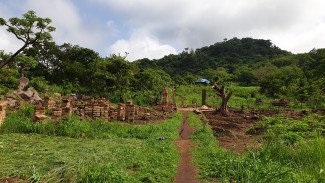From research to action, Uganda focusing on facilitation to spur economy and create jobs
Uganda has one of the fastest growing economies in Africa, as well as a fast-growing population.
Its exports in 2017/18 increased by 7.23% from the previous year, according to the Uganda Ministry of Trade, Industry and Cooperatives, and this was largely driven by the country’s dominant agriculture sector.
But with a population set to exceed 60 million by 2030, the country has work to do to create jobs for its booming citizenry, as well as to avoid overdependence on any one commodity. According to the World Bank, Uganda needs to create more than 600,000 jobs per year by 2030 in order to keep up with the number of people entering the work force.
Back in 2005 the government embarked on an effort to improve Uganda’s economic prospects, with such growth shown to lead to employment gains and resulting poverty alleviation in a country with approximately one-third of the population living below the extreme poverty line.
“We started with a study, a diagnostic study on our economy. And we looked at commodities but we also looked at the broader economy. And we realized that as much as we were engaging in trade and investment that there are lots of constraints that our private sector was experiencing, considering the fact that it is a private sector-led economy,” Uganda Minister of Trade, Industry and Cooperatives Amelia Kyambadde said.
Kyambadde is referring to Uganda’s Diagnostic Trade Integration Study (DTIS), which is analysis supported by the Enhanced Integrated Framework (EIF) that helps to define a country’s export competitiveness strategy and offers recommendations to support growth, job creation and institutional improvements.
FACILITATING
The study of Uganda and its update in 2013 found positives in the country’s move to export-led growth, while recommending continued economic diversification. It stated that regional integration could be a key vehicle for achieving the nation’s economic goals, with markets in goods and services helping to diversify the country out of commodities as well as supporting smaller-scale traders who do informal business across borders.
“This study and the revised DTIS identified the economic and sector-specific constraints to the growth of trade and proposed priority actions addressing the constraints. I am very proud to stand here and announce that we as Uganda have actually addressed those constraints and have attempted to ensure that we have overcome [them],” Kyambadde said.
“That study was very effective for our economy because it was an eye opener to the challenges we have,” she added.
Addressing the country’s actions following these trade analyses, Kyambadde referred to a web-based Non-Tariff Barrier Reporting System that had reduced costs and delays in moving goods across borders, the construction of three One Stop Border Posts that have eased the movement of people and goods, and the development of an Electronic Single Window System that has cut clearance times for imports and exports by 25%.
GOING REGIONAL
For Samuel Ssenkungu, Director of Trade at the Ministry of Trade, Industry and Cooperatives, Uganda’s partnerships with its neighbours in the region are fundamental to a bright trade future.
“We started with a strategic trade agreement in the late 1990s and we moved to a common market for the East African Community [EAC] and we now have a customs union. So we attach great importance to the development of our regional economic block because the peoples in these countries are almost our brothers and sisters. Borders separate us … but we share quite a lot in common,” Ssenkungu said.
Regional organizations that Uganda is now a part of like the EAC, the Common Market for Eastern and Southern Africa (COMESA), the Tripartite Free Trade Area and the African Continental Free Trade Area (AfCFTA) are now contributing to the country’s trade enhancements.
Kyambadde said, “It is in the EAC and COMESA regions where Uganda recorded a positive trade balance since 2007. Our trade balance was US$383.9 million in 2007, rising to US$615.7 million in 2016.”
The country also is increasingly playing a role as a distribution hub for other nearby countries and regions, as it also provides with its agricultural yields.
FOOD BASKET
Ssenkungu said, “Uganda is strategically located. It is a land-linked country linked to all these countries around us. We are endowed in terms of natural resources and good weather… We call ourselves the food basket of the region… Our production of maize alone is five million metric tons annually but as a nation we can consume only one. So if we can manage our post-harvest losses we can feed East Africa on maize.”
Looking at Uganda’s agriculture sector, a 2018 World Bank report found untapped employment potential with the country’s agriculture, which already provides 70 per cent of the country’s employment opportunities and contributes to about one-quarter of gross domestic product (GDP).
“There are a number of food products that we believe have export potential with our neighboring countries. Maize is one of them as well as beans, sugar, rice, pineapples, coffee, tea. But we also recognize the fact that the majority of our exports are raw materials and in the long run we want to develop capacity to add value to some of those products that we sell outside so they are able to fetch higher value,” Ssenkungu said.
In addition to this potential in processing is also that of the country’s many individual traders, who may work informally, unofficially and whose businesses selling across borders are massive, even with little infrastructure or support networks.
“The majority of cross border trade is unofficial where you have local or small-scale traders crossing on a bicycle and it is not regulated – and that is one of the biggest challenges. We want to make sure trade is formal and in that regard we are working with COMESA to set up zones at the border crossing points that have storage facilities. So instead of traders crossing into the interior of the county that can interact at the storage facility at the border post… We also want to establish processing facilities at those border export zones,” he said.
With Uganda’s economy driven by small enterprises and the self-employed, and a booming young population, the opportunities are there to foster additional growth and, as the government has been doing, facilitate trade so as to maximize its potential.
If you would like to reuse any material published here, please let us know by sending an email to EIF Communications: eifcommunications@wto.org.



